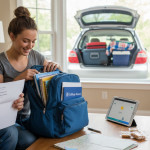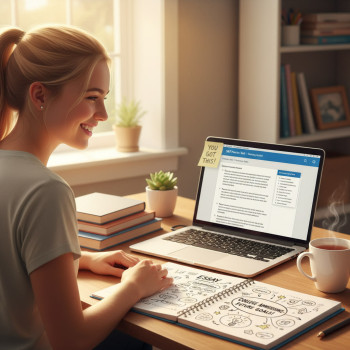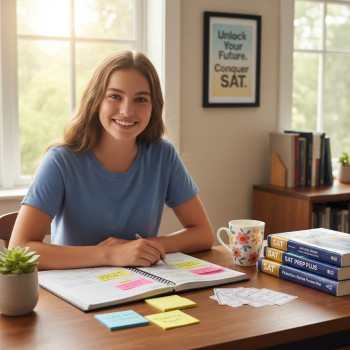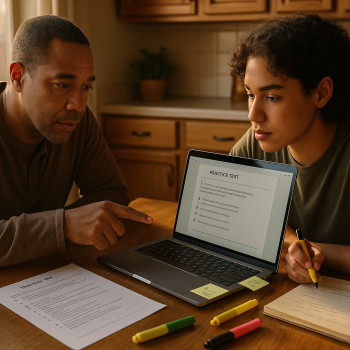Why a test-day checklist matters more than you think
Imagine this: you’ve studied for months, hit new personal bests on practice tests, and finally arrive at the door of your test center feeling ready. Then you realize your device isn’t charged, your admission ticket is buried in an old email, or your ID photo looks nothing like you this morning. Those small, preventable slips can wipe away calm faster than a 30-minute section. A thoughtful, personal test-day checklist does two crucial things: it prevents avoidable mistakes and it carves out mental space so your brain can focus on the SAT itself. This guide walks you through creating a checklist that’s practical, realistic, and calming—so you walk into test day confident, not chaotic.
Start by building your checklist categories
A checklist that actually helps should be short, organized, and actionable. Break it into clear categories that reflect the test flow: Preparation the week before, the night before, the morning of, in your bag, and mental & timing strategies. Below are robust items for each category—pick what applies to you and leave the rest. The point is to make the list yours.
The week-before essentials
This is not a time for cramming content; it’s a time for logistics, practice, and peace of mind. Treat the week before like a tech rehearsal for the exam.
- Confirm test appointment and logistics: double-check the test date, start time, and location in your Bluebook app and any admission ticket details.
- Device readiness: run the Bluebook test setup if required on your device and make sure the app is installed and updated. If your school provides a device or you plan to borrow one, confirm availability and compatibility.
- ID check: make sure your physical acceptable photo ID matches the name and photo on your admission ticket. If you use a school ID, verify school policy about name format or valid dates.
- Practice under test-like conditions: do one or two short, focused practice sections on Bluebook or the official practice platform—just enough to keep timing fresh without burning out.
- Plan back-up solutions: identify a backup device, charger, or a route to the test center in case of unexpected delays.
- Pack items for comfort and focus: practice with the calculator you’ll use, test any external mouse or keyboard if you’ll bring one, and try a sample snack you plan to eat during the test break.
Night-before checklist
The night before should be about rest and simple preparations—think of it as setting the stage for success, not squeezing in a last-minute study marathon.
- Charge everything: device, portable battery, and any other electronics you’ll carry. Plug in an hour earlier than you think so you’re not charging when you should be sleeping.
- Print or screenshot your admission ticket if you prefer a paper copy—Bluebook typically makes the ticket available a few days before the test; have it ready in an easy-to-reach place.
- Lay out your outfit and pack your bag: choose comfortable, layered clothing for unpredictable testing-room temperatures. Include pens, pencils, permitted calculator, water bottle, and snack for the break.
- Set two alarms: one on your phone (placed away from your bed) and one backup alarm or ask a family member to check on you in the morning.
- Do a relaxing wind-down: light stretching, a short walk, or breathing exercises—avoid screens for at least 30 minutes before bed when possible.
Morning-of checklist
Keep the morning predictable and calming. Your checklist here is about routine: you want a familiar set of actions so your test-day brain doesn’t invent new worries.
- Eat a reliable breakfast: aim for protein + complex carbs (e.g., eggs and whole-grain toast or yogurt with fruit and granola).
- Final device check: make sure Bluebook launches, battery is at a healthy level, and the charger/power bank is packed.
- Bring printed admission ticket or have it ready on the device you’ll use to access Bluebook setup if instructed.
- Photo ID on top: place your acceptable photo ID where you can’t miss it (keys, wallet, or clipped to the inside of your bag).
- Dress in layers and include a jacket or hoodie; testing rooms vary in temperature.
- Review a short positive ritual: a 3–5 minute breathing exercise, reading a calm affirmation, or visualizing a smooth start can reduce adrenaline spikes.
What to pack: the must-haves and the maybes
Below is a clear split between items College Board expects and helpful extras you might bring if allowed. Use this as the backbone of your physical checklist in the bag.
Must-haves (do not leave home without)
- Fully charged testing device with Bluebook installed and exam setup completed—test setup is often required within a few days of testing.
- Printed or easily accessible admission ticket generated by Bluebook.
- Acceptable physical photo ID matching your registration name exactly.
- Pen/pencil for scratch work (even with digital tests, scratch paper and pencils are used).
- Allowed calculator (or plan to use the built-in Desmos calculator in Bluebook).
Nice-to-haves (bring if they help you stay comfortable)
- Portable charger or power cable for your device (outlet access is not guaranteed).
- Water and light snack for the official break—nothing messy or fragrant.
- A watch without an alarm if you like keeping track of time (remember the app has a timer).
- Earplugs for sensory calm—only if permitted by your test center or as part of accommodations.
Sample test-day timeline you can adapt
A structured timeline helps you avoid the “where did the time go?” panic. Below is a sample timeline for a typical Saturday SAT administration; adjust it to your specific start time and commute.
| Time Before Test | Action |
|---|---|
| 24–48 hours | Final device setup, print admission ticket, confirm route/transport, pack bag |
| Night before | Charge device, lay out clothes, set alarms, sleep early |
| 2.5–3 hours before | Wake up, eat breakfast, review quick calming breathing |
| 1–1.5 hours before | Leave for test center—account for traffic and check-in time |
| 30–45 minutes before | Arrive, check in with test center staff, find seating |
| Test start | Follow proctor instructions, begin using Bluebook timer, pace yourself |
| Break | Snack, quick stretch, mental reset, refocus |
Timing strategies and small habits that add up
Beyond packing and logistics, a checklist should include tactical reminders about pacing and small habits that protect concentration during the test.
Pacing reminders to include
- Start by surveying the section: spend the first 30–60 seconds scanning the section so you know where to allocate time.
- Answer easy questions first within each passage or problem set; mark and return to harder items.
- Use the Bluebook app timer but keep an eye on section milestones (e.g., if you have 30 minutes for a section, mark what you want done at 10– and 20-minute marks).
- Don’t dwell: if a question stalls you more than a minute, mark it for review and move on to preserve momentum.
Mindset reminders
- Progress over perfection: treat each question as an opportunity to gain points, not a judgment on your worth.
- Refocus quickly after mistakes: if you miss one, let it go and reset for the next question; carryover emotion costs time and accuracy.
- Controlled breathing: a 4-4-4 box breath (inhale 4s, hold 4s, exhale 4s) during short pauses can steady nerves.
Personalizing your checklist: a template you can copy
Here’s a compact daily template you can print or type into your notes app. It’s written as short commands—check them off one by one.
- [ ] Confirm test date/time/location in Bluebook
- [ ] Complete Bluebook exam setup and print admission ticket
- [ ] Check acceptable photo ID is physical and current
- [ ] Charge device to 100% and pack charger/power bank
- [ ] Pack pens/pencils, allowed calculator, water, snack
- [ ] Lay out clothes and pack layered outfit
- [ ] Set alarms and plan commute with extra buffer time
- [ ] Do a short calming routine (breath, visualize success)
Quick troubleshooting: common test-day snafus and fixes
No checklist can eliminate surprises entirely, but anticipating a few common issues and adding contingency steps to your list will make you resilient.
Forgot admission ticket
Don’t panic. If you can’t find a printed ticket, open Bluebook on your device or another synced device and access the admission ticket there. Leave ample time to re-download or reprint if needed.
Device battery low
Carry a fully charged power bank in your bag labeled for ’emergency use only.’ If you arrive and your device won’t hold charge, politely ask test-center staff about device-lending options or exam rules in your setting.
ID issue
If your photo ID doesn’t match the name on your admission ticket, speak with test-center staff immediately—this is often resolvable if you have supporting documentation like school records or notarized forms. The best prevention is matching names on registration and ID well ahead of test day.
Adding help where you need it: tutoring and targeted support
While many students will do fine with practice and a plan, some benefit from targeted guidance to get the most from their preparation time. Personalized tutoring can help you refine pacing strategies, identify weak areas, and build a day-of routine that suits your personality. If you’re considering outside help, look for programs that offer 1-on-1 guidance, tailored study plans, and tutors who track your progress carefully. Sparkl’s personalized tutoring, for example, offers one-on-one guidance, tailored study plans, expert tutors, and AI-driven insights that can help turn your checklist from a passive list into a practiced, reliable routine—especially helpful in the final weeks before the test.
Two final rituals to add to your checklist
Rituals turn a checklist into a calming habit. Add these two short rituals to the top of your day-of checklist and practice them in the week before the test so they feel familiar.
One-minute visual check
Before you lock your bag, do a fast scan—admission ticket, ID, charged device, pencil, calculator. Say each item out loud as you touch it. Speaking aloud and touching the item anchors it in your memory and reduces the chance you’ll forget it in a hurry.
Two-breath reset
During the transition to each section, take two slow, intentional breaths to re-center. This short pause is surprisingly effective at clearing frustration and sharpening attention.
Checklist final thoughts: practice the plan, don’t just make it
Creating a test-day checklist is a small act with outsized impact: it reduces cognitive load, lowers stress, and frees your brain to do what it’s practiced for—think clearly under timed conditions. But the checklist only works if it becomes routine. Run through your checklist during practice sessions, simulate a test-day morning at least once, and ask a trusted friend or tutor to run a quick “did you pack X?” check when you’re packing your bag the night before. When the items and rituals become muscle memory, the SAT becomes just another task you’ve prepared for deliberately.
One last encouragement
Test day is one chapter—important, yes, but not the whole story. Prepare thoroughly, lean on systems (like a simple checklist), and if you need extra structure, consider personalized support that matches your learning style. With the right plan, a calm routine, and a reliable checklist, you’ll walk into the room ready to show what you can do.
Printable compact checklist (copy and paste)
Here’s a compact version you can paste into a notes app or print and check off the night before or the morning of the test.
- [ ] Confirm Bluebook setup & admission ticket
- [ ] Physical photo ID in wallet
- [ ] Device charged + charger/power bank packed
- [ ] Calculator (or plan to use built-in calculator)
- [ ] Pens/pencils and scratch paper supplies
- [ ] Light snack & water for break
- [ ] Layered clothing and comfortable shoes
- [ ] Two alarms set + commute plan with buffer
- [ ] Quick breathing ritual ready
Resources for follow-up
Make one more checklist item: identify one person you can text when you finish the test—someone who will celebrate your effort, not interrogate your score. Keeping the emotional arc of test day humane and social makes it less of an isolated performance and more of a milestone you can be proud of—no matter the outcome.
Ready when you are
Use this guide as your starting point, tailor it to your needs, and practice it. The more you use your checklist, the more second-nature it becomes. And if you want help building a personalized pre-test routine or refining where to focus your last weeks of study, consider one-on-one tutoring that integrates checklist coaching into a tailored study plan. You’ve done the work—now give yourself the calm, clear path to show it on test day.














No Comments
Leave a comment Cancel